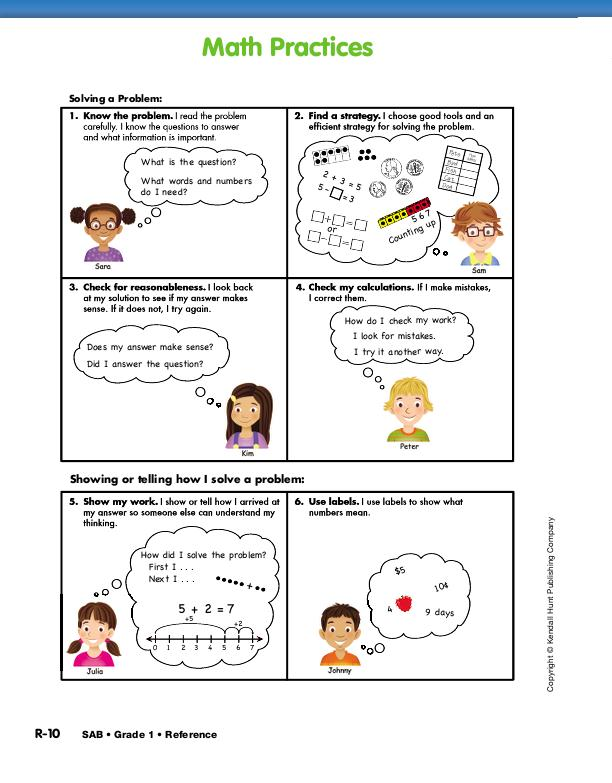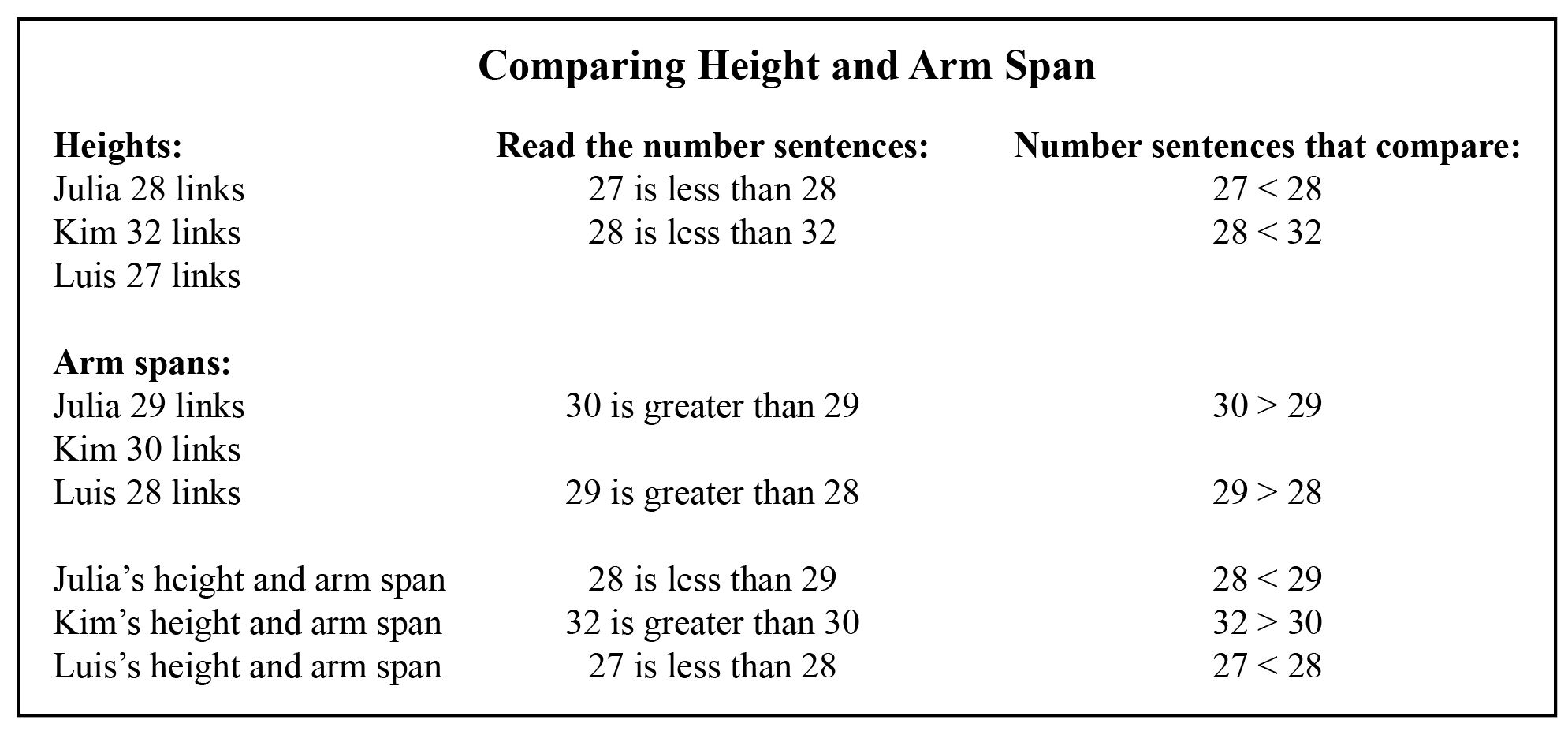Write Comparison Statements about Height and Arm Span. Begin the lesson by briefly revisiting the
activities students worked on in this unit.
- Several days ago we measured and compared clouds. What were we measuring? (How big they were by finding the area of each cloud.)
- How did we find the area of each? (We used pennies to cover the clouds then counted to see how many pennies each took.)
- Another day we helped Goldilocks measure rectangles. What were we measuring then and how did we do it? (We measured area using square-inch
tiles and we measured how long each side was using inches on a ruler.)
- On our Tiles 1 and Tiles 2 pages we measured areas of shapes then compared the areas. How was that different from measuring and finding the
areas of Goldilocks’s bed and the unusual mats? (On the Tiles pages we used square-inch tiles and for the bed and the mats we used square units.)
- What did we measure in the Rolling Along lab? (The distance the car traveled using connecting links.)
- What other units have we used to measure length? (“inches” in Unit 7)
Refer to Math Practice 6, Use labels, on the display of the Math Practices page from the Reference section of the Student Activity Book.
- I remember we did a good job using labels with the measurements. We compared many measurements
including lengths of sides, areas, how tall or wide shapes were, and talked about which were
biggest or smallest. I remember talking about some measurements being “greater than,” “less
than,” or “equal to” other measurements. Let’s focus on comparing some measurements using these words today.
Explain that you will measure the heights and arm spans of several students.
- What would be a good tool to use to measure the heights of students in our class? (a chain of connecting links, a big ruler, e.g., yardstick or meterstick)
Demonstrate arm span by holding your arms stretched out at shoulder height.
- Arm span is the length from fingertip to fingertip. What should we use to measure the length of my
arm span? (connecting links, a big ruler, e.g., yardstick or meterstick)
- How should I label the measurements? (links or inches)
Ask three students to come to the front of the class; students should have visibly differing heights.
Measure and record their heights in links on the board or on chart paper. Then follow the same procedure
measuring and recording their arm spans. On the board or chart paper, record the heights of the
three students in one area and the arm span measurements in another area. You will add to the display as
the lesson progresses introducing and using symbols to compare measurements. Allow enough space on
your display for these comparison sentences. See Figure 2 for an example of a completed display.
Compare the heights of the three students. Record the comparison statements on the Comparing Height
and Arm Span chart you have already started. Focus on “less than” comparisons.
- Look at the height measurements and the three students. Put them in order from shortest to tallest.
- Compare [Luis’s] height to [Julia’s] height. (Luis is shorter than Julia.)
- Compare their measurements. (27 links is less than 28 links.)
- Compare [Julia’s] height to [Kim’s] height. (Julia is shorter than Kim.)
- Compare their measurements. (28 links is less than 32 links.)
- Are there any measurements that are equal?
- Look at the arm span measurements and the three students. Put them in order from shortest to longest.
Compare the arm span measurements of the three students. Continue to record the statements on the
Comparing Height and Arm Span chart. This time, use “greater than.”
- Look at the arm span measurements. Compare the measurements using the words “greater than.”
Complete the sentence: _____ is greater than ____ . (Some possible responses: Kim’s arm span is greater than Julia’s arm span; 30 is greater
than 29; 29 links is greater than 28 links.)
Write Comparison Statements About the Length of Objects. Refer students to the Compare to 10
Links page in the Student Activity Book and distribute 20-link chains to each pair of students. Ask half of
the students to work on Question 1 and the other half to work on Question 2. Organize students to work
with a partner as they complete their assigned question. After most students have completed their statements,
ask students to work on the question they did not complete. If students are done early, ask them to
work on Question 3. Students are challenged to measure objects less than or greater than 10 links and
complete comparison statements comparing that measurement to 10 links. After students have completed
Questions 1–2, ask a few students to share their comparison statements.
Have student pairs answer Question 3.
- Do you think there is an easier way to write these comparisons? (Possible responses: Circle the larger number; circle the smaller number; maybe there is a symbol.)
As students learn to use the “greater than” and “less than”
symbols, focus on the comparison rather than a convention
for remembering how to use the symbols. Help students
develop ways to remember which symbol is used to show
“greater than” and which is used to show “less than.” Display
the Comparison Symbol Chart you prepared throughout the
school year. This will provide the support students need to use
this representation.
Asking students to identify the greater number and then
identifying the symbol will help you determine if students are
making accurate comparisons and choosing the appropriate
symbol to show that comparison.
Use the Comparison Symbols. Explain to students
that mathematicians use special symbols to represent
the comparison words instead of writing all the
words each time they compare quantities. Display the
Comparison Symbol chart you prepared. See
Figure 1. Revisit the comparison statements written
on the Comparing Height and Arm Span chart. Write
each statement using the “less than,” “greater than,”
or “equal to” symbols. See Figure 2.
- What do you notice about the “less than” symbol in
these number sentences? (It’s little and pointy on
one side and big on the other. It goes small to big.
The small side is by the smaller number.)
- What do you notice about the greater than symbol
in these number sentences? (It’s flipped. It’s big
on one side and small and pointy on the other. It
goes big to small. The big side is by the bigger
number and the small pointy side is still by the
smaller number.)
- What do you notice about the equal sign? (It’s even. Both lines are the same, not big or small, just both the same.)
Use other measurements from the display and add number sentences using symbols.
















